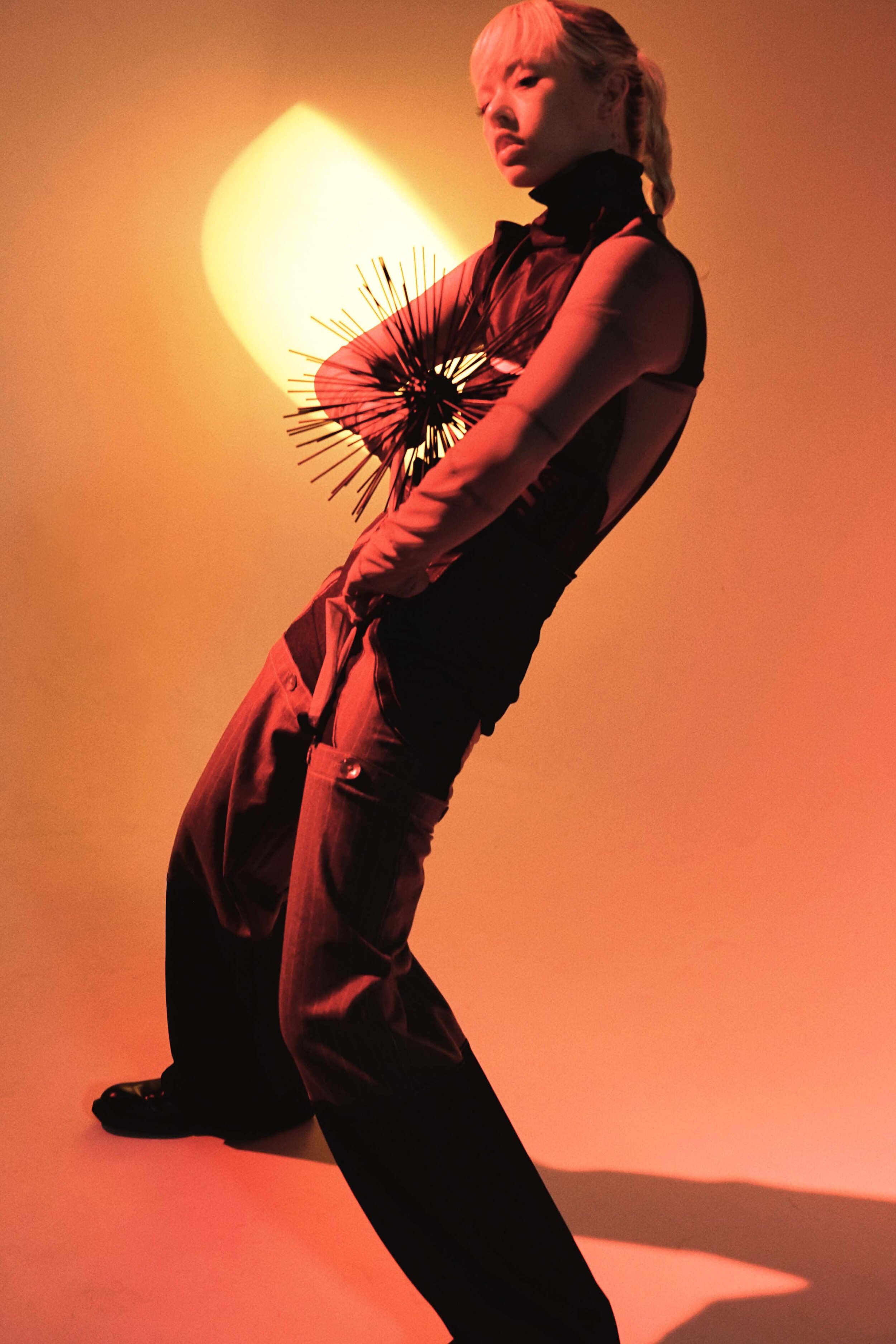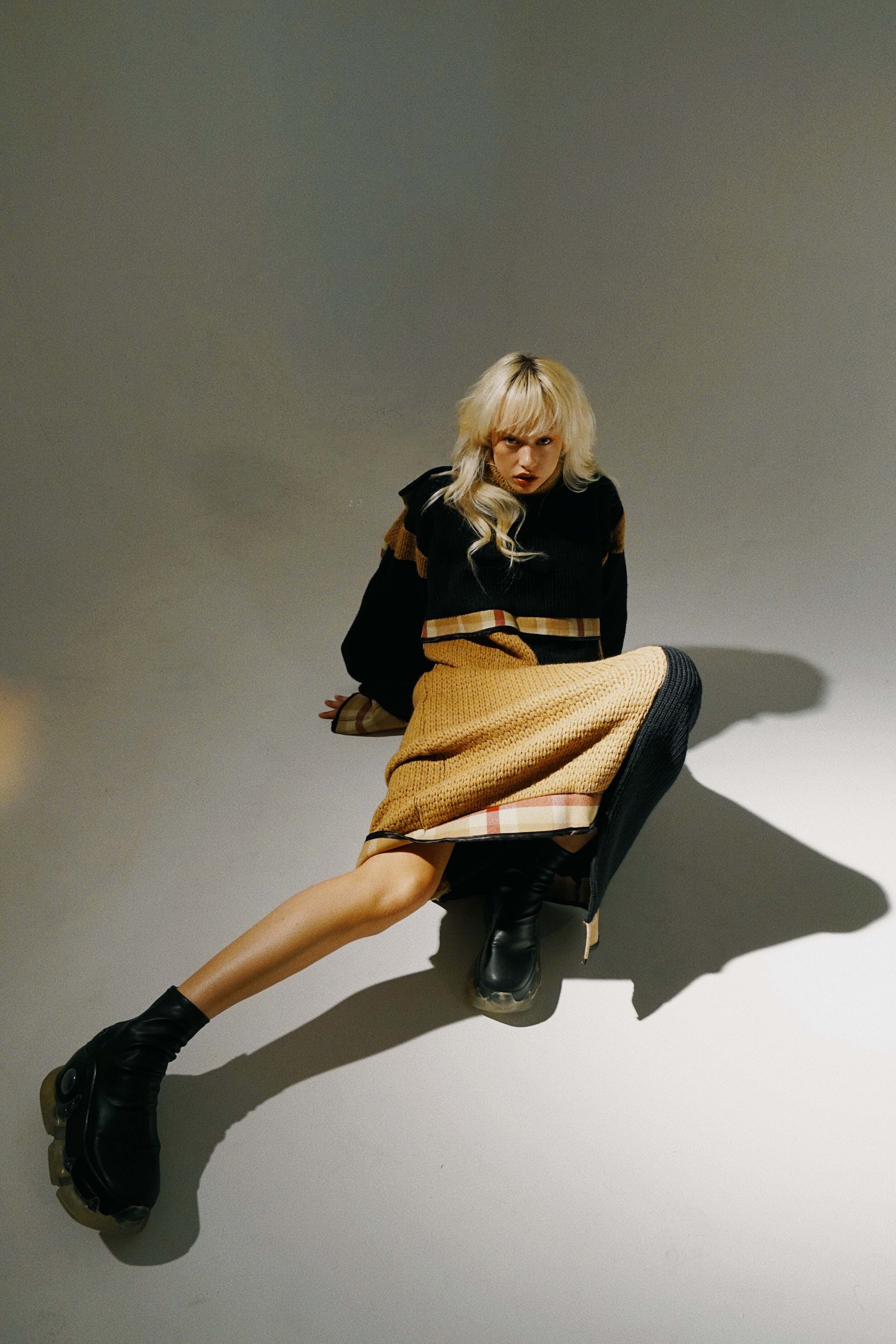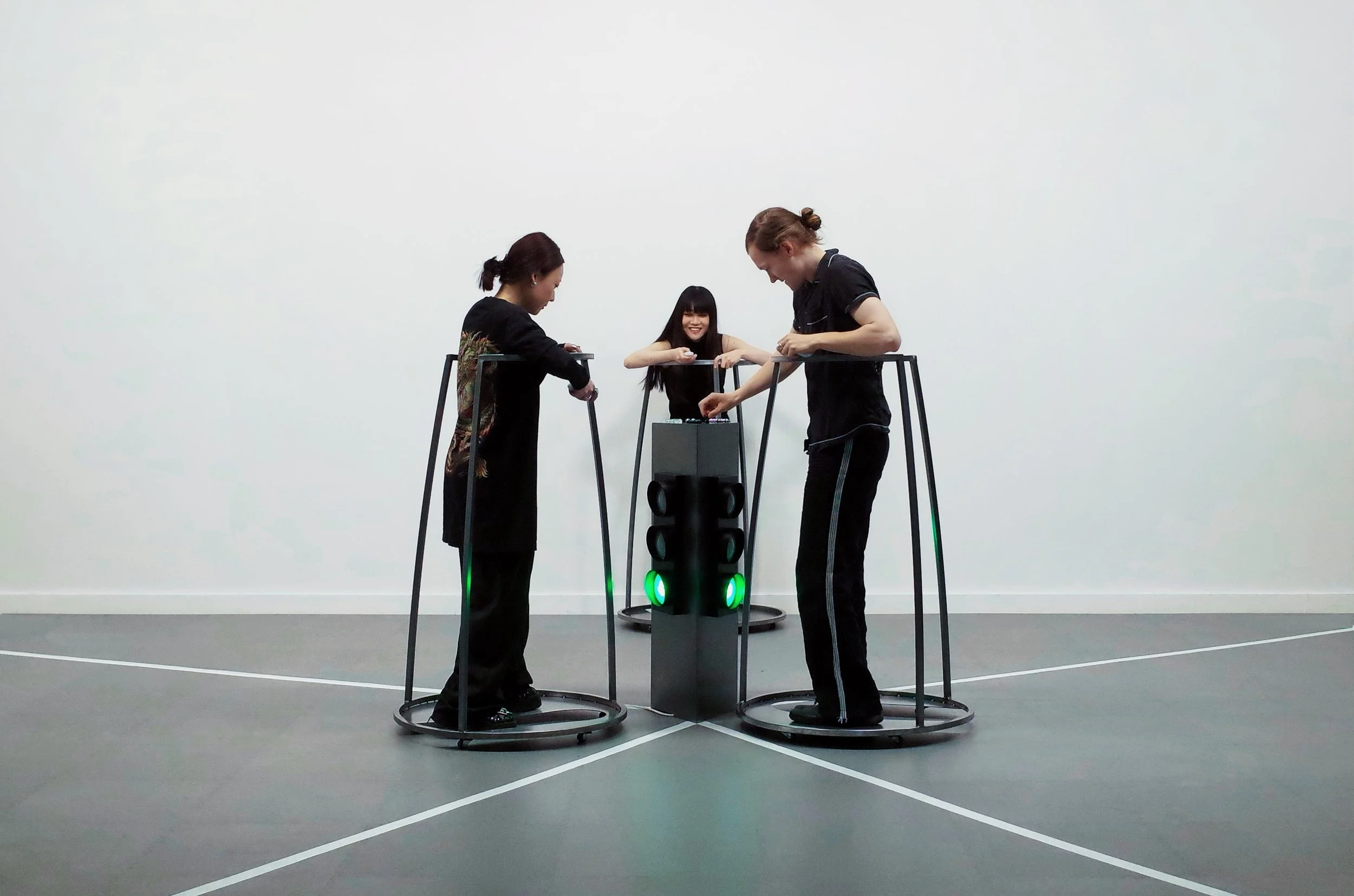10 Questions with LI MO
LI MO is a Los Angeles-based fashion and knitwear designer that grew up in Shenzhen province in China. When she was just 16 years old, she started her life journey in the United States. Her artwork is largely inspired by the collision of eastern and western culture. She aims to bring diverse ethnicities, architecture, cultures, and high artistic tastes into her artwork. In 2015, LI MO graduated from the Fashion Institute of Design and Merchandising with an AAS degree.
She has been continuously chasing her dream, with her persistent passion for fashion paving her way to one of the most renowned fashion schools in the world, Fashion Institute of Technology, and graduated with a BFA degree in 2020. During her time living in New York, she has worked for fashion brands, including NAADAM and Carlisle Etcetera. The experiences from the professional industry have encouraged LI MO to work with other artists and photographers that have shaped her impressive portfolio. Her work has been published by several fashion magazines, including L’officiel, 17:23, Shuba, Superpresent, AL-Tiba9, LE’COEUR, CRI.com, KNOW, SAINTEIGHT, MOEVIR, and POZA, etc. She has held a solo exhibition at the Art Show International in California. In addition, she has been featured in selected group exhibitions throughout the United States held by the Shoreline Art Festival, Art Gallery 118, Fusion Art, and Las Laguna Art Gallery. LI MO has even gained international recognition with a showcase in London at the Infinity Exhibition held by The Holy Art.
Li Mo Portrait
ARTIST STATEMENT
LI MO’s artworks reflect her own experiences and have formed her talented mind and creative vision. It explores the distinctiveness and newness of the world. She characterizes her signature aesthetic through elevating the innovation of spirituality and unique design.
INTERVIEW
Let's start talking a little about yourself. You left China at an early age to follow your dream to become a fashion designer. What did motivate you so much to take such a big step?
Ever since I was a child, I was eager to become a person like Leonardo da Vinci, who had a strong unrestrained curiosity and extremely vibrant creative mind. I believe the potential ability of each one of the people in the world is infinite. Hence, when I was 16 years old, I stepped out of my hometown in China and went to what is for me a strange and undefined country, the United States, to explore the possibilities of my life. I started my career as a fashion designer as I have a talent for exploring the beauty of life. Thus, I got ready to transform my ideas and present them in a 3-D form to the world.
Tell us more about your studies and work experiences. What are the experiences that shaped the designer you are now? Did you have any aha moment along the path, or did you have it all clear from the very beginning?
I got two degrees in fashion design major, with AAS and BFA from Fashion Institute of Design and Merchandising and Fashion Institute of Technology. I undeniably wouldn't have become a confident designer with an independent personality without professional skills and knowledge. Moreover, keeping in touch with talented classmates and people allowed me to get involved in an art vibe. Nevertheless, professors' critical judges and negations pushed me to jump out of stable thinking patterns and traditional mode, encouraging me to stay foolish and hungry. Comparing school life with my work experiences, I have worked at the company NAADAM, CARLISLE ETCETERA, and RHUDE in general, restraining myself in a good way. I realize that to be an accomplished fashion designer, I should be familiar with customers' demands and the market. Nothing is accomplished overnight. I never think I have it clear what kind of person I will become or know which plan of my life is necessary. I insist on the accurate decisions that I made at this moment and do it. The implementation is always more practical than a perfect plan. Luckily, I took part in the process behind the SS22 Paris fashion show of RHUDE, where I had quite an important position as technical designer. This elevated me to another critical role level, and I had the chance to run through the process from the designs, Tech packs, and production orders. Therefore, the position is essential for me to achieve my dream closely.
Explore © LI MO
Explore © LI MO
Explore © LI MO
Your knitwear work has intricate patterns and styles. Why did you choose to work with knitwear? Does it give you more freedom of expression compared to textile only?
Before learning knitwear, I have to mention one of my favorite brands from Japan named SACAI, intelligently combining knit with woven fabrics. That enlightened my interest in developing fabric manipulation. When I just started my fashion degree, together with other classmates, we looked for existing materials from the fabric stores, but they made me feel a limitation in creativity. Later, finding out the method of using knit was an extraordinary treasure. It means each piece can have a thousand variations according to the stitches and gauges of yarn. That motivates me to deepen my research on knitwear. One of my works - “Explore” - is dedicated to knitting and consists of a hand-knit sweater and a pant, made with a Stoll machine and mixed with woven fabrics. “Explore” has been featured in multiple fashion magazines, including the world-recognized well-known France fashion magazine L’officiel, which permanently published my collection “Papillon” in their editorial.
How do you design your pieces? What are your influences, and who is your ideal customer?
Most of my works begin with abundant research to discover the topics I want to touch. I later start sketching. After I have finalized all the looks, I begin to look for fabrics or yarns, then start the pattern making and sewing process. Lastly, I make adjustments during the model fitting. I wouldn't say I am forever satisfied with a work that I have done in the past or will be done in the future. I mainly focus on how I feel when I see the work at the moment it is finished.
It is a similar emotion with the tattoos on my arms. I did my first tattoo six years ago, and I don't feel much enthusiasm now compared to how I felt back then. However, I never thought of washing it out because I respect each stage of my life and the opinion I had back then, since it made me into who I am now.
There is no limitation to my ideal customer. It can be a woman, a man or genderless. I totally disagree with disrespectful judgments on women's bodies. Women can be beautiful and bold no matter what their shape is. If I have to choose a style to describe my work, I would define it as unisex. Even though I was born as a woman, I shouldn't be judged for having a different personality and character inside my inner world. That is how I see the world with diversity and inclusiveness.
Spark © LI MO
Spark © LI MO
Do you have any role models or figure you particularly look up to when it comes to style and design?
I usually look for inspiration from choosing people I know or I am familiar with as role models. One of my works - "Spark" - is inspired by my mother. "Spark" reflected the profound relationship between my mother and me and her unique personality of softness and rigidity. “Spark” has been exhibited at the Las Laguna Art Gallery and published in multiple well-known magazines such as L’officiel, Al-Tiba9, 17:23, and Shuba.
Not only a beloved family relationship can inspire my works, but also my close friends, co-workers, and my pets. I don't choose a celebrity as my role model, since the news of them are the opinions from a third person, which is not realistic and exaggerated most of the time. Moreover, the audience shouldn't stop their path for how sophisticated and elegant the work is. I hope the audience can find the depth of it, exploring my story and experiences.
Have you ever thought about starting your own brand? Or would you like to work for bigger, more established brands? And if so, would you lean more toward street style or luxury fashion?
I can be sure of this answer. I will definitely achieve it. However, I don't think it conflicts with me working for other brands. Numerous well-known fashion designers have their own brand and are creative directors of other brands simultaneously. It is necessary to work for other brands to absorb the experiences from experienced specialists, and it is an excellent opportunity to be involved in a real market. A good idea is not enough to build up a successful fashion brand. It requires knowing what the customer demands and adjusting your style to adapt to society and design a salable product. A sophisticated but unpractical garment can be an art but not a product, and the creator can be named as artist and not a fashion designer. There is no border between streetwear and luxury fashion. A well-known artist Virgil Abloh is a good example. He owns his own brand Off-white, and at the same time, he works as creative director for Louis Vuitton. Living in the era of rapid development and information spreading means each one of us can be an influencer and a fashion icon. The society we live in today is highly tolerant of beauty. Therefore, I will never restrict myself in relation to what my style should be. As you can see from my works, such as “Spark“, “Explore” and “Blue Mood”, I tried on a minimal and effortless style, where structures and silhouettes are inspired by the well-known interior designer Zaha Hadid, and the bold colors used are inspired by 1960s Pop art. I believe that if I insist on doing the correct thing and put 100% effort into it, time will deal with the rest.
Blue © LI MO
Recently, we are witnessing growing attention toward sustainable fashion. Where do you stand in this regard? Do you embrace this movement, or is it just greenwashing?
The fashion industry is one of the main contributors to the problem of environmental pollution. I support sustainability in fashion for sure. However, mass production causes remaining wasteful materials, which are predictable and inevitable when running a fashion business.
The way to solve this problem is to use particular fabrics, such as organic cotton or organic wool, avoiding the use of the fabrics such as polyester or nylon, which cause contaminating materials and produce a lot of chemical substances when they are recycled. Meanwhile, fashion designers should design the garments with functionality and practicality so that they can be worn every day. One of my works, “Shadow”, has achieved the goal of sustainability fashion. It is a functional raincoat made with vinyl and artificial leather. This functional raincoat can be worn multiple ways, as the outside jacket can be separated by snaps from the inside long coat and worn as a separate garment. The design of “Shadow” keeps the fashion appearance and functionality at the same time.
Covid-19 has deeply impacted the art world. With fewer exhibitions and art fairs, artists and galleries had to find other ways to showcase their work. How much did the global pandemic impact the fashion world? Did you find different ways to show your work as well?
There is no doubt that Covid-19 has impacted our life. Losing people’s lives was a painful experience for all of us. However, there is always a flip side. Covid-19 has changed the way we live and work. It includes the shutdown of factories, which decreased the pollution to the environment. Also, the rise of virtual garments such as Tribute Brand and Carlings has gradually become a trend in the fashion industry. During the year of Covid-19, I was aspiring to find out a chance to show my works. Therefore, numerous exhibitions started moving their in-person visits to online showcases, allowing people to spend their time visiting the online pages. Although we had the unavoidable regret of not seeing an actual work, this was a chance for people from all over the world to get to know the talented fashion designer Li Mo, who has showcased her works in exhibitions such as Las Laguna Art Gallery, Art Gallery 118, The Holy Art – Infinity Exhibition, and which has already shown the world that she is a world-recognized successful artist and fashion designer.
Surround © LI MO
Surround © LI MO
What do you wish to accomplish this year, both in terms of career goals and personal life?
Unsurprisingly, more than half of this year has already passed. Compared to 2020, when we were all quarantined at home because of the pandemic, this year was relatively better, and changes took place. For the time being, it is my responsibility to play a good role in the position of the technical designer at RHUDE, where I am currently working. I keep learning with people from all different areas.
I also keep enriching myself with reading, which should become a hobby you keep for the rest of your lives, no matter what industry you are in. Reading for me is essential to expand and raise the knowledge base and establish a correct point of view.
I do have a goal, and I have already started working on it. I began to prepare my own fashion brand and label, which I plan to launch in 2022 based in Los Angeles. Moreover, I have been invited to work with a talented furniture designer, Jialun XIong. Her newest design Skelton Chair is going to feature my knit and textile design.
Finally, any shows or publications where our readers can find your work?
I have my works published in multiple well-known magazines, such as L’officiel, 17:23, MOEVIR, Shuba, POZA, SAINTEIGHT, etc. Besides that, I have exhibited in Las Laguna Art Gallery, Art Gallery 118, The Holy Art – Infinity Exhibition, etc. Also, I have some online personal interviews and showcases such as Not Just A Label, IDEN.CN, CRI.CN, Art Show International – Solo Exhibition, etc., where you can find out my works. You can also follow my personal Instagram, and website. It is such an unforgettable experience to share my experiences with all of you. I will see you in the near future.



























